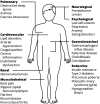Obesity-induced ocular changes in children and adolescents: A review
- PMID: 37033164
- PMCID: PMC10076676
- DOI: 10.3389/fped.2023.1133965
Obesity-induced ocular changes in children and adolescents: A review
Abstract
Childhood obesity has reached epidemic levels worldwide. Overweight and obesity is associated with an increase in several inflammatory markers, leading to chronic low-grade inflammation responsible for macro- and microvascular dysfunction. While the impact of obesity on overall health is well-described, less is known about its ocular manifestations. Still, there are few studies in children and adolescents in this regard and they are inconsistent. However, some evidence suggests a significant role of overnutrition in the development of changes in retinal microvasculature parameters (wider venules, narrower arterioles, lower arteriovenous ratio). Higher values of intraocular pressure were found to be positively correlated with high body mass index (BMI) as well as obesity. In addition, the retinal nerve fiber layer (RNFL) values seem to be lower in obese children, and there is a significant negative correlation between RNFL values and anthropometric and/or metabolic parameters. Changes also could be present in macular retinal thickness and choroidal thickness as well as in the retinal vessel density in children with obesity. However, these associations were not consistently documented. The purpose of this review is to present the most current issues on child obesity and the related potential ocular effects through an overview of international publications from the years 1992-2022.
Keywords: childhood obesity; intraocular pressure; ocular signs; optical coherence tomography; retinal microvasculature; retinal nerve fiber layer.
© 2023 Dezor-Garus, Niechciał, Kędzia and Gotz-Więckowska.
Conflict of interest statement
The authors declare that the research was conducted in the absence of any commercial or financial relationships that could be construed as a potential conflict of interest.
Figures
Similar articles
-
Evaluation of intraocular pressure and retinal nerve fiber layer, retinal ganglion cell, central macular thickness, and choroidal thickness using optical coherence tomography in obese children and healthy controls.Niger J Clin Pract. 2019 Apr;22(4):539-545. doi: 10.4103/njcp.njcp_471_18. Niger J Clin Pract. 2019. PMID: 30975960
-
An Assessment of Retinal Nerve Fiber Layer Thickness in Non-Diabetic Obese Children and Adolescents.J Clin Res Pediatr Endocrinol. 2018 Mar 1;10(1):13-18. doi: 10.4274/jcrpe.4810. Epub 2017 Jul 24. J Clin Res Pediatr Endocrinol. 2018. PMID: 28739552 Free PMC article.
-
Noninvasive assessment of the retina and the choroid using enhanced-depth imaging optical coherence tomography shows microvascular impairments in childhood obesity.J AAPOS. 2016 Feb;20(1):58-62. doi: 10.1016/j.jaapos.2015.10.006. J AAPOS. 2016. PMID: 26917074
-
Relationship of Obesity and Related Disorders with Ocular Parameters in Children and Adolescent.Curr Eye Res. 2021 Sep;46(9):1393-1397. doi: 10.1080/02713683.2021.1884727. Epub 2021 Feb 15. Curr Eye Res. 2021. PMID: 33586562
-
Deep Retinal Layer Microvasculature Dropout Detected by the Optical Coherence Tomography Angiography in Glaucoma.Ophthalmology. 2016 Dec;123(12):2509-2518. doi: 10.1016/j.ophtha.2016.09.002. Epub 2016 Oct 18. Ophthalmology. 2016. PMID: 27769587 Free PMC article.
Cited by
-
Association of childhood obesity on retinal microvasculature and the role of biochemical markers for its early detection.BMC Ophthalmol. 2025 Mar 10;25(1):118. doi: 10.1186/s12886-025-03942-y. BMC Ophthalmol. 2025. PMID: 40065277 Free PMC article.
-
Association between insulin-like growth factor-1 and ocular surface parameters in obese prepubertal boys.Eur J Pediatr. 2024 Nov;183(11):4807-4816. doi: 10.1007/s00431-024-05748-4. Epub 2024 Sep 5. Eur J Pediatr. 2024. PMID: 39235603
-
Early exposure to Western Diet exacerbates visual outcomes in female mice.bioRxiv [Preprint]. 2024 Dec 3:2024.11.27.625688. doi: 10.1101/2024.11.27.625688. bioRxiv. 2024. PMID: 39677769 Free PMC article. Preprint.
-
Evaluation of the Effect of Body Mass Index and Waist Circumference on Ocular Health Parameters in Children and Adolescents.Children (Basel). 2025 Mar 26;12(4):413. doi: 10.3390/children12040413. Children (Basel). 2025. PMID: 40310070 Free PMC article.
-
Associations between ocular biometry and anthropometric measurements among Sudanese adults.J Med Life. 2024 Sep;17(9):903-907. doi: 10.25122/jml-2024-0292. J Med Life. 2024. PMID: 39628970 Free PMC article.
References
-
- Bentham J, Di Cesare M, Bilano V, Bixby H, Zhou B, Stevens GA, et al. Worldwide trends in body-mass index, underweight, overweight, and obesity from 1975 to 2016: a pooled analysis of 2416 population-based measurement studies in 128·9 million children, adolescents, and adults. Lancet (London, England). (2017) 390(10113):2627–42. 10.1016/S0140-6736(17)32129-3 - DOI - PMC - PubMed
-
- Obesity and overweight. Available at: https://www.who.int/news-room/fact-sheets/detail/obesity-and-overweight(cited 2022 Mar 24).
-
- Childhood Obesity Facts | Overweight & Obesity | CDC. Available at: https://www.cdc.gov/obesity/data/childhood.html(cited 2022 Mar 24).
-
- Vogel M, Geserick M, Gausche R, Beger C, Poulain T, Meigen C, et al. Age- and weight group-specific weight gain patterns in children and adolescents during the 15 years before and during the COVID-19 pandemic. Int J Obes. (2021) 46(1):144–52. Available at: https://www.nature.com/articles/s41366-021-00968-2(cited 2022 Mar 24) 10.1038/s41366-021-00968-2 - DOI - PMC - PubMed
Publication types
LinkOut - more resources
Full Text Sources


